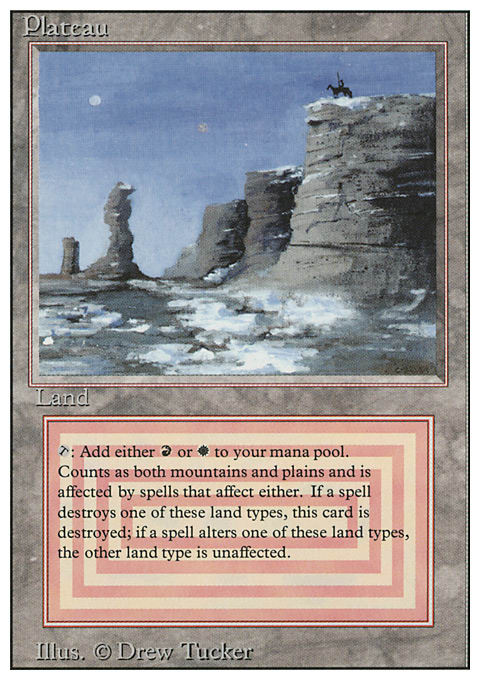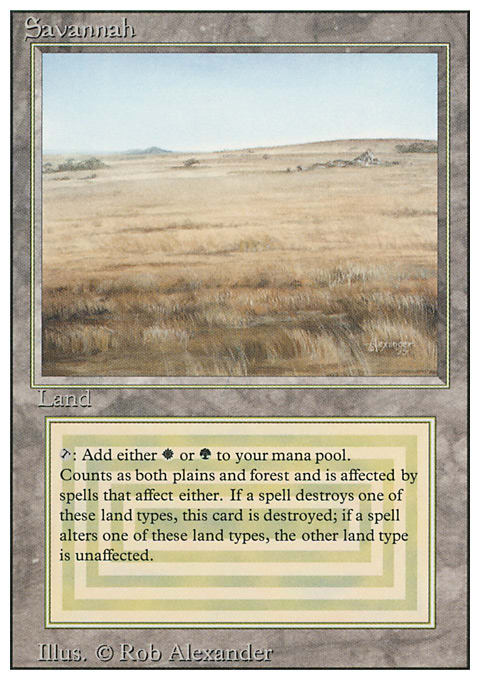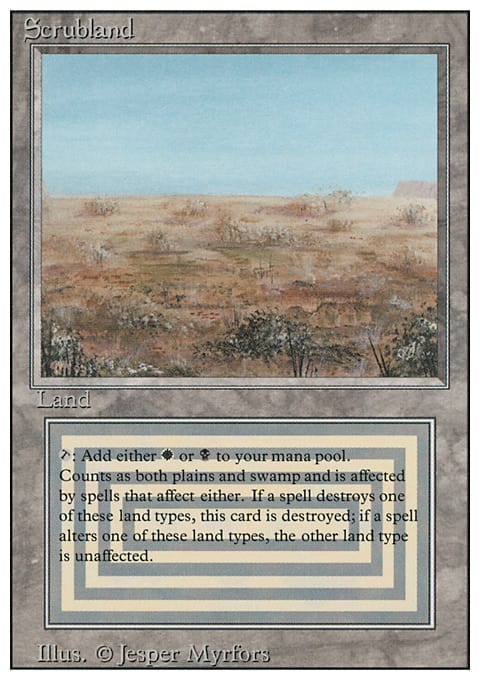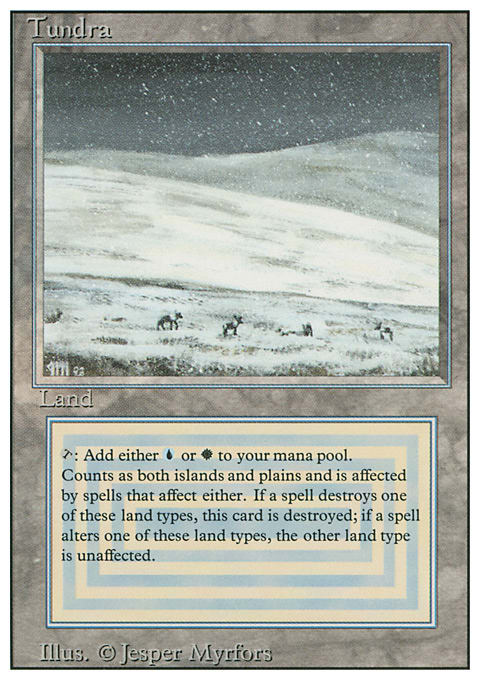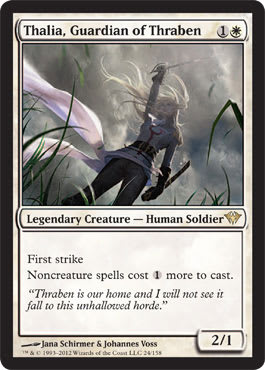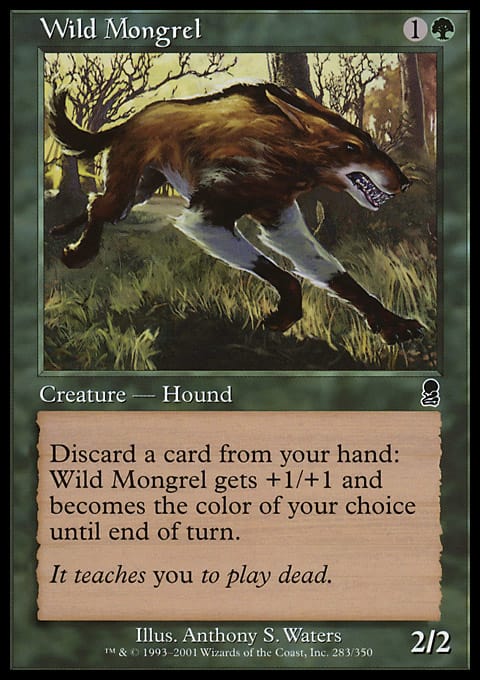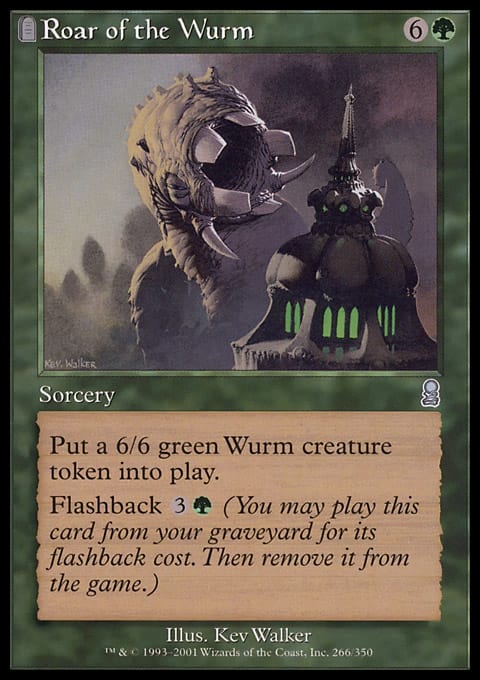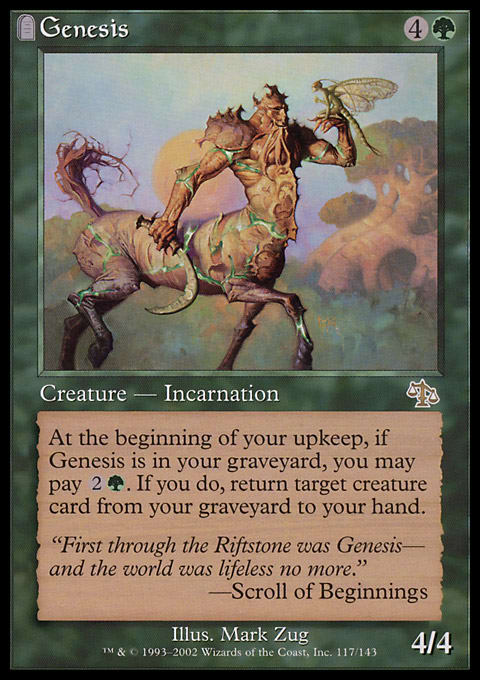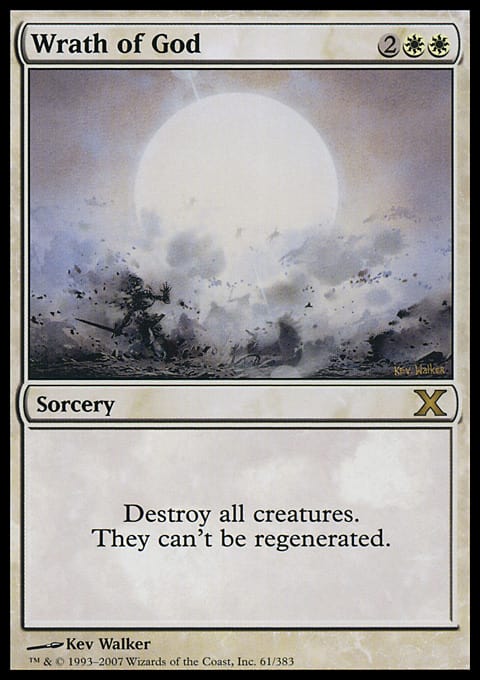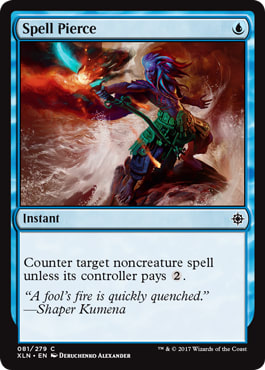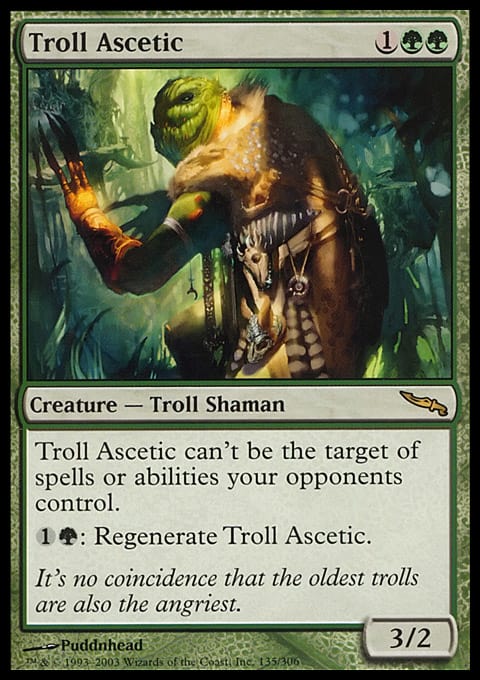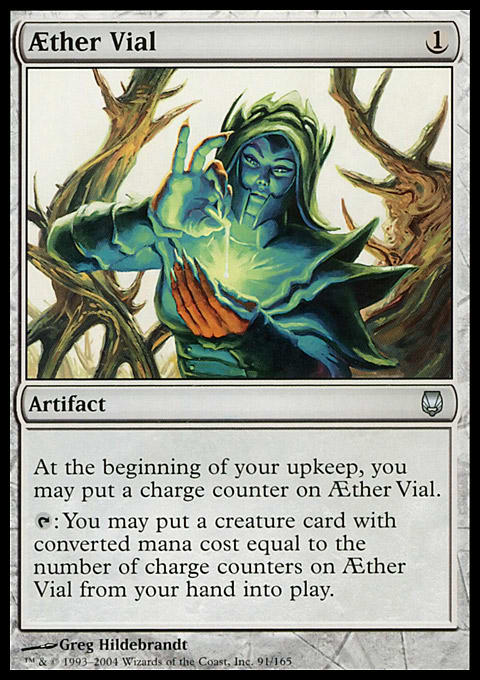"People are saying to Mike outside, 'Sorry about your friend, Mike. He had a great day, did really well, but he's gonna lose.'
"Mike replies calmly, 'No. He will win. He's gonna Choking Sands that land and Consult for Kaervek's Spite.'
"'How many Spites in the deck?'
"'Just one.'
"'Yeah right. Whatever.' Someone even offered Mike a wager on it.
"This all happens outside in the hallway, without me knowing until after the match.
"Guess what I did? I laid land, let him Tax, Choking Sands his Savannah bringing him down to 5, next turn, drop a fourth land, Consult for Spite.
"'COME TO ME, MY BURLY PROTECTOR!'
"Spite. I had sided out Spite in like half my matches today, but this time, for some reason, I left it in. Holy Pikula."
-Albert Tran, Team Discovery Channel; February 2, 1998
One of the most iconic moments of early PTQ reporting - a Demonic Consultation for a singleton Kaevervek's Spite - drew into sharp relief the line separating creature decks. There are, essentially, only two kinds:
- Those that can win with something other than combat-based creature damage, and
- Those that can't
While most critics imagine this as an axis around Red Decks and not-Red Decks, it isn't so simple. Today, Dimir decks can exhaust your library with Ruin Crabs, not just beat you down with Rogues. Back 1in 1998, the deck altran played in that PTQ was actually Mono-Black. An offensive deck based around inexpensive weenie creatures - your Black Knight, the underappreciated Barrow Ghoul - could also do loads of damage outside of combat. Choking Sands represented two essential life points bridging the gap to a lethal Kaervek's Spite, but it closed out a lot of games with Cursed Scroll activations. And the one Stench of Evil? In a format full of these...
... It was like a one-sided - and sometimes quite painful - Armageddon.
Of note: Nether deck has a Mountain anywhere near it.
To my mind, after learning the basics of card advantage, the most important fundamental skill the aspiring tournament player has to pick up is how to play - with and against - the two main kinds of creature decks.
The focus in this article will be around the ones that don't have what Adrian Sullivan used to call "reach" (before the ability to block flying creatures was a keyword). Let's look at a Red Deck from earlier this year:
Mono-Red Aggro | THB Standard | Sebastian Pozzo, Magic World Championship XXVI
- Creatures (28)
- 2 Grim Initiate
- 2 Torbran, Thane of Red Fell
- 4 Anax, Hardened in the Forge
- 4 Fervent Champion
- 4 Rimrock Knight
- 4 Robber of the Rich
- 4 Runaway Steam-Kin
- 4 Scorch Spitter
- Instants (2)
- 2 Infuriate
- Sorceries (4)
- 4 Light Up the Stage
- Artifacts (4)
- 4 Embercleave
- Lands (22)
- 18 Mountain
- 4 Castle Embereth
Despite being actually Mono-Red, this deck doesn't really have the character of a Red Aggro deck. It's half creatures... And some buff cards. Four cheap card drawing... And that's it!
I chose Pozzo's deck from that tournament because unlike others of similar stripe, Pozzo's doesn't even play Bonecrusher Giant in the main deck! This isn't actually a perfect example of what I wanted to illustrate conceptually; but it is a great example of a deck that doesn't really have reach (despite being Red).
That said, Pozzo's deck has a lot of the trappings of a deck that fights a defender's Plan A on the same axis.
... We'll talk about this in a second.
Plan A:
Write this down.
When you're playing against a creature deck without reach, focus on these two things:
- As long as you can keep your life total above zero, they probably can't win.
- If you simply kill all their creatures, they can't reduce your life total to zero.
It is difficult for some players to internalize how basic but important this paradigm is. Because certain creature decks without reach are fancy! They have highly disruptive threats...
... Or really powerful creatures...
... Or just really big ones:
But for a lot of these decks, just kill all their guys. They can't win outside of The Red Zone. So, don't play them on any axis where they are comfortable. Because if you let them execute, or decide what interactions are important, often they will be able to disrupt you with their awesome disruptive guys, or overpower you with their walking Black Lotuses, or bury you under a combination of size and card advantage.
Just focus on killing their guys!
Think about how you can play to keep their guys out of The Red Zone!
Back in the 1990s, geniuses like Erik Lauer and Eric Taylor explored concepts like "more-sies". One deck might have tons of these exciting elements: Card draw, card power, card quality, whatever (but won with creatures). The other deck could just add up all their removal. "Wow," they might realize. "I don't have as much card drawing as they do, but I have way MORE ways to kill creatures than they have creatures to kill me with. Ergo, I have more-sies."
An important strategy in the heyday of Upheaval-Psychatog in Standard (and Extended!) was that board control decks that could pick a fight with Smother on 'Tog's turn (and follow up with Innocent Blood or Chainer's Edict on their own turn) could just kill every Psychatog, even through multiple permission spells. Psychatogs that had not been set up via Upheaval were highly vulnerable to the sheer tonnage of removal. Even slow sorceries like Mutilate could help to exhaust a very short roster.
My Plan A versus Your Plan A
The most basic way to combat the defensive "Plan A" is to run cards (primarily creature cards) that resist or seek to out-last removal.
Every time a White Weenie player uses Hunted Witness instead of the Savannah Lions of the day, that is part of what they are doing. If the bet is that the opponent is answering your threats one-for-one, running creatures that can't be [fully] answered one-for-one will upset the defender's paradigm. This is doubly magnified by land counts. Creature decks without reach typically play fewer lands than control decks or board control / removal decks. In the long run that translates to "card advantage" if everyone is drawing only one card per turn.
"But MichaelJ," you understandably object. "The Control deck is unlikely to be drawing only one card per turn!"
That's true, but only when fighting their Plan A on the Plan A axis. A Red Deck - like Pozzo's, above - adopting Grim Initiate has learned from the White Weenie decks that have come before. Isn't this an angled sort of drawing extra cards? More explicit takes on the same showcase various creature decks' willingness to trade short term damage for lasting power and card advantage.
Now, clever Control decks know that they are unlikely to win if their entire plan is drawing answers one-for-one. Not only are they going to eventually miss a beat by drawing a land at the wrong time, the fact that they need to spend some deck space to a victory condition or two may exacerbate the problem.
Plan A, Director's Cut
... Which is why so many Controlling decks over the years have gone the route of the sweeper. Wrath of God, Day of Judgment, Languish.
Creature decks without reach similarly know about the existence of these sweepers, and can plan accordingly.
Most sweepers are sorcery speed. While effective ones can be as cheap as 2-3 mana (depending on how small your creatures are), bangers like Supreme Verdict or Crux of Fate will cost four, five, or even more mana. A single discard or permission spell might be all a creature deck needs to ensure that God never gets angry and its Fantastic Creatures - not Magical Spells - that win the day. Resilient threats with regeneration or specific types of protection can also be effective.
... But I'd like to highlight a very different angle of attack.
We differentiated two types of creature decks up top by whether or not they had "reach". But it's actually possible to play like you have reach, even when you don't.
Humans | Modern | Eli Loveman, Mythic Championship II
- Creatures (37)
- 1 Militia Bugler
- 2 Deputy of Detention
- 3 Kitesail Freebooter
- 4 Champion of the Parish
- 4 Mantis Rider
- 4 Meddling Mage
- 4 Noble Hierarch
- 4 Phantasmal Image
- 4 Reflector Mage
- 3 Thalia, Guardian of Thraben
- 4 Thalia's Lieutenant
- Artifacts (4)
- 4 Aether Vial
- Lands (19)
- 1 Island
- 1 Plains
- 1 Seachrome Coast
- 4 Ancient Ziggurat
- 4 Cavern of Souls
- 4 Horizon Canopy
- 4 Unclaimed Territory
- Sideboard (15)
- 1 Militia Bugler
- 1 Deputy of Detention
- 4 Auriok Champion
- 3 Damping Sphere
- 2 Dismember
- 1 Gaddock Teeg
- 1 Sin Collector
- 1 Whirler Rogue
- 1 Izzet Staticaster
Modern Humans does a really good job of highlighting how a creature deck without reach can overcome the fundamental limitations of its archetype.
While Humans is still vulnerable to opponents with lots of removal, it can operate through powerful sorcery speed sweepers better than most creature decks. For two reasons.
Mantis Rider is one of the best cards in the Humans deck. When I made Top 8 of Modern Regionals a couple of years back, I sided in Deflecting Palm against my Humans opponent to lock Top 8. This might seem odd. The whole point of this article is that Humans doesn't play the kinds of cards that we typically side Deflecting Palm in against (you know, burn).
But because of Mantis Rider, it can act like it has reach.
While Mantis Rider is strictly a creature that needs to attack [for damage] to win the game, its combination of haste and evasion lets it act kind of like a burn spell. If you get two or more swings in, all the better.
I sided in Deflecting Palm knowing this. I was confident my Grim Lavamancers could keep most of the Humans off the battlefield, but Mantis Rider had 3 toughness plus the aforementioned haste and evasion. I didn't love the idea of getting hit by one mid-game. Who knew how much life I would have invested stabilizing the floor?
Put simply, Mantis Rider can go to the face like a Lightning Strike, even if it is about to get swept up like any other creature come the opponent's main phase.
The other reason is the best card in the deck:
This card gives almost any creature a kind of pseudo-haste. Not actual haste; and it doesn't make any random creature the equal of Mantis Rider... But it does let you attack with at least one guy through sorcery speed sweepers. At least once, that is.
Okay... If you're on the Control side, how do you play around these kinds of elements?
The first thing you will want to do is set your life point threshold at a number higher than 1. If you know that your opponent plays single-use burn-like haste creatures (a la a StOmPy with Groundbreaker) you won't want to intentionally go below 7 on your own turn. You might have to be more patient with your developmental casts, leave up permission or instant speed removal, etc. even if you don't actually have it. The threat of an answer might be as effective in the short term as the answer itself.
Subtly, you might want to prioritize winning. Against decks without haste you can often play super slowly and methodically. After all, as long as your removal is out-lasting their attrition capabilities, your schedule doesn't matter as much. But if the opponent can consistently get damage in before you can answer, you actually stand to lose, even when it should feel locked up.
LOVE
MIKE
















